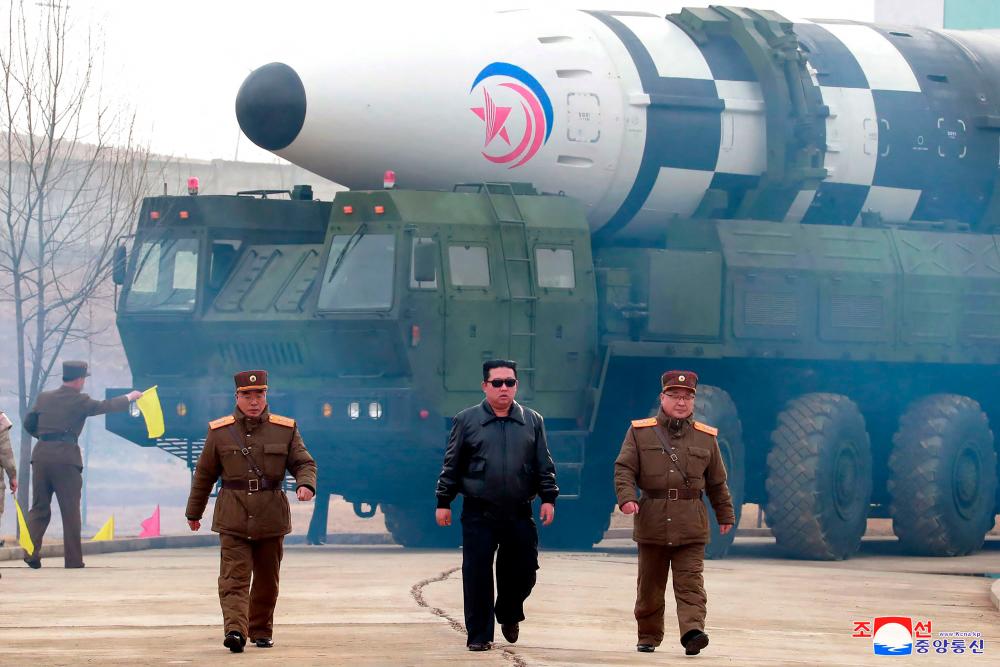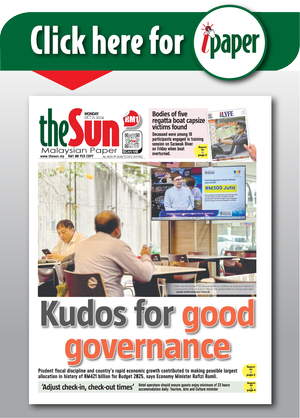THE recent flurry of missile tests by North Korean President Kim Jong-un in a show of defiance further upended the calculations of regional balance of power.
The sabre-rattling started early this year with the resumption of ICBM tests disguised as satellite launches, culminating with the launch of the most advanced missile to date, the Hwasong-17 last week, which is within the range of strategic manoeuvres by Kim in reading the security spectrum and cost benefit calculations in his immediate need for assurances and survival.
Although critics have argued on the real success of the Hwasong-17 ICBM, which is touted by Pyongyang as its crème de la crème with its longest duration on air and the farthest range of manoeuvrability, and in theory is capable of delivering multiple warheads to anywhere in the US continent, the operational success in these ventures further up the ante in regional fear and the subsequent retaliatory moves.
While it remains highly dangerous, security analysts expressed scepticism on the real capabilities in carrying multiple nuclear warheads and the capacity to withstand re-entry into the atmosphere with the capacities intact at such an altitude and duration.
Notwithstanding the real threats imposed, Seoul and Tokyo were the first to get the jitters and a flurry of responses were initiated.
Regional wariness on the looming threats by the Axis of Autocracies as termed by critics, with the new-found strength and consolidation of support in the structure of Moscow-Beijing-Pyongyang in capitalising on certain shared interests, is further compounded by its internal inability to mount an equal level and effective deterrence.
While regional players were temporarily relieved by US President Joe Biden’s pivot to normative assurance and alliance solidification, the actual terms are deemed insufficient, and worries abound on Washington’s long-term staying power with potential changing policies in the future under different presidencies.
Increasingly, they are keen to align more closely and openly with key players and Washington in signalling a clear and measurable deterring and counter-action under an expansive nuclear and conventional security umbrella.
Threats and counter-threats involving nuclear annihilation in the peninsula have already created jitters even before the new presidency is officially in store in the South.
Incoming President Yoon Suk-yeol has already opened the floodgates to further deterioration of the regional security climate with his defiant stance for a more hard-line and hawkish deterrence against Pyongyang, with a series of defensive postures with alliances forged with Tokyo and Washington, and hopeful for more assurances of defensive support from Washington, which his delegations have requested during their visit to the US this week.
Although he won by a thin margin from a neck and neck race with his Democratic rival, he realises that conventional methods of dealing with Kim do not yield the intended results, with even worse implications for Seoul’s security assurance.
The efforts and policies in the past to please Kim and in practising strategic patience in dealing with Pyongyang seem to be a utopian and futile strategy for Suk-yeol.
It is this reason for his promise in his campaigns in requesting for the redeployment of American nuclear capacities should conflicts flare in the peninsula.
He also sensed the prevailing sentiment of the public in the South where many would opt for hosting American nuclear weapons in putting to rest the deficiency of counter-threats and deterrence that Seoul is in possession now.
It remains to be seen whether the bold risk taken by Suk-yeol will be effective or backfire.
Of pertinent interest will be whether Kim will actually take the deterrence posed seriously or will it only antagonise him in warranting further irrational actions and to undertake pre-emptive strikes in cancelling and preventing the supposed pre-emptive strikes by Seoul.
It is as much as certain as China President Xi Jinping will not give up Taiwan as will Kim in not giving up his powerful nuclear weapons as the ultimate deterrence and power exertion, at least in the near term.
Unless clear, committed, collective and measurable assurances and guarantees are given, at the same time in terms that are not violating the long-term survival of Kim’s regime, it is hard to foresee he will erode his only powerful deterrence at his disposal.
The US presidency is another factor to consider, with arguments that Kim is forced to play into the hands of Donald Trump with his unique no-holds-barred approach, and that in facing Biden, he is forced to again resort to past proven effects of this escalatory threats for greater returns in seeing no clear differences or unconventional measures from Biden.
During attempts to straighten out the positions under Trump, Kim foresaw the once-in-a-lifetime opportunity to seal the ultimate breakthrough, but the cost-risk calculations were too lopsided for Washington to continue.
Kim aspires to be different and to stamp his own legacy in aiming for a final peaceful breakthrough, but he realises that he needs Western nodding in giving him the face-saving transition and the last say to portray to the nation that Washington somehow acknowledges the wisdom and strength of the Kim regime in coming to this compromise and peaceful conflict resolution.
In this regard, Kim believes he has time on his side, unlike China’s Xi, with his youth and ruthless displacement of others who challenge him and an unhindered free hand in dictating policies with the support of his handy elites led by his sister Yo-Jong.
The long game is his to lose and, along the way, outlines further goals to bolster his military capacities particularly in enhancing the accuracy and range of his missiles and also targeting next frontiers with the likes of nuclear submarines and multiple warhead capacity of his ICBMs.
While he calculates that he can still rely on Xi and Putin, he is also observant of the fact that he is increasingly being used as an effective tool in their own strategic and calculated peripheries in their dealings with the West.
However, the reality at hand does not seem to be rosy as in Kim’s projection.
He faces both internal and external squeezes with the full-blown impact from climate challenges, and a strengthened alliance of democracies and the Western order in threatening to upend internal food security and external survival.
As time drags on, there is only so much Pyongyang can prepare for the long ball game of withstanding the natural chain effects of the non-traditional threats that will persistently pose problems for his population more than him personally.
He cannot afford the emergence of fault lines in his circle of elites, what more the potential for one among the masses.
There is also only so much momentum and progress that he could caulk up in sustaining effective and trusted first strike capacities, and at the same time stalling the second-strike readiness and capabilities in leaving them vulnerable to first strike counter-measures from Washington or even Seoul.
This will render Pyongyang’s nuclear deterrence and its long held first strike threat to be less lethal and more obsolete, giving greater space for the West to act further.
The prospects of deterrence and MAD (Mutually Assured Destructions) will also greatly diminish in the long run as Washington develops a better and more holistic interceptive capacity with its unrivalled technological and military advancement, which will provide better first-strike prevention and an enhanced second-strike impact that will render Pyongyang’s past mechanism to futility.
This signals that time certainly is not on the side with Kim and that the window for greater dialogue, engagement and diplomacy is fast closing in terms that will be beneficial for him in the long run.
All eyes have been fixated on the next potential move by Pyongyang in its celebration of Day of the Sun on the 110th anniversary of the birth of its founding father Kim Il-sung on April 15, whether it will resort to a nuclear test, which will be a first since 2017, or refrain from a further escalatory push.
Analyses based on ground movements and preparations seem to indicate that a major nuclear test is imminent, in pushing the momentum gained from the breaking of its self-imposed moratorium on long range testing.
The rationale for such moves, at least in Kim’s view, warrants the subsequent international condemnation and sanctions, and further narrowing the path for conciliatory dialogue and openings.
Like Putin, he has long tasted Western sanctions and retaliatory responses with seemingly little detrimental and hindering effects.
He can still count on Xi and Putin for now, but as the cost-benefit fulcrum increasingly tilts towards jettisoning Pyongyang for their own national needs and survival, and coupled with the inescapable multi-pronged challenges to his nation’s survival, he might recalibrate his strategic manoeuvres and grab the opening for a stunning transformation twist which will stamp his legacy in a different realm.
Or he might be tempted to remain defiant and stay on to the last straw of MAD. The rest of the world certainly roots for the former. Only time will tell.
Comments: letters@thesundaily.com









